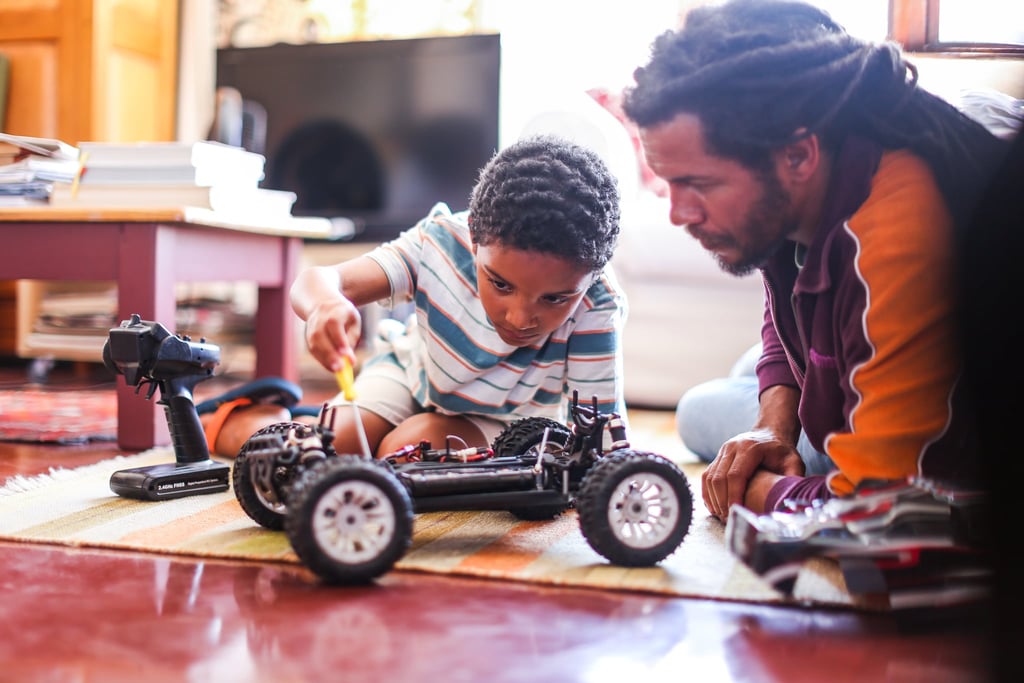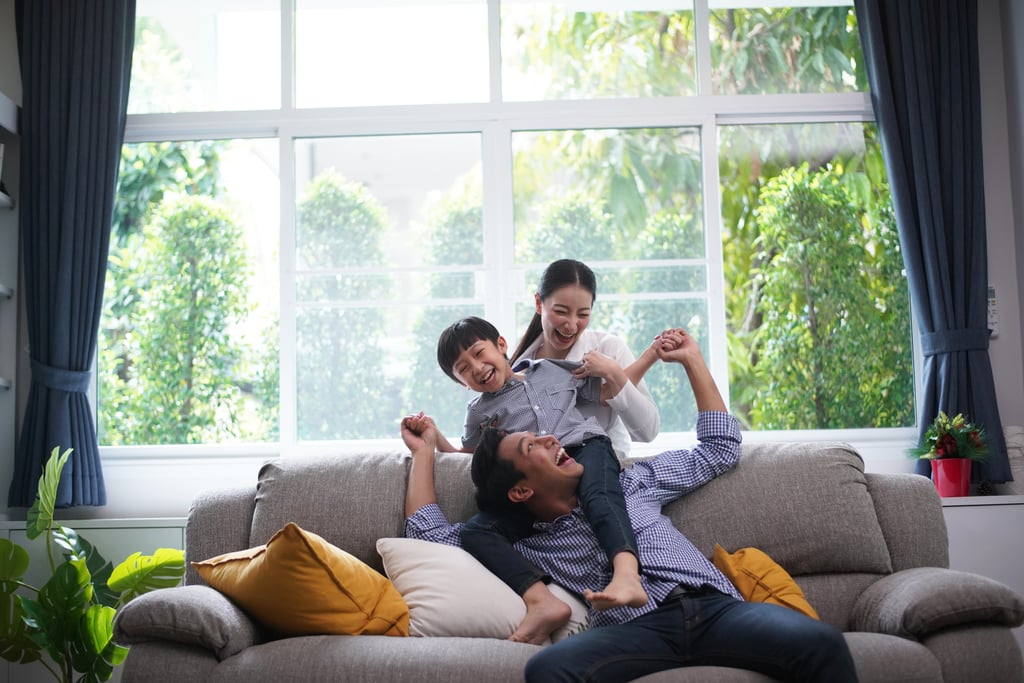In our house, Mr. Dinger and Ms. Ringer [1] are the dynamic duo and, in my opinion, the power couple of 2020. They're our timers. Their dings, rings, and chimes can be heard sounding throughout our home on any given day signaling that we are doing a time-in. Introduced to me by Dr. Harvey Karp [2] in his book The Happiest Toddler on the Block [3], time-ins have changed our parenting.
Dr. Karp describes time-ins as the opposite of a time-out [4] and suggests using them to raise happy, patient, cooperative children [5]. A timer (given a cute, kid-friendly name, hence Mr. Dinger and Ms. Ringer) is set, and for the full predetermined amount of time, the parent plays or sits with the child. No distractions. No cellphones. No TV. Just full undivided attention [6]. When the timer goes off, the activity is over, and the parent can leave the child's side to tend to whatever they have to do. You can start a time-in at any age. We typically never set the timer for more than 30 minutes and never for fewer than five minutes. Sprinkling in these time-ins throughout the day has really helped our parenting and thwarted temper tantrums that would have otherwise arisen due to lack of attention. Besides the lack of temper tantrums, our family has fallen in love with time-ins for several reasons.
They break up the day.
A full day with babies and toddlers can feel like an endless stretch of monotonous routine [8] to figure out how to entertain them. Days can drag on as parents furiously rack their brains on what to do next. Oftentimes, this can lead to parents giving up and turning popping a kid in front of a TV into longer than they'd like.
However, with time-ins, Dr. Karp calls them "bite-size bits." They break up the day to satisfy a child's appetite for Mommy and Daddy. I like to write down our schedule for the next day the night before, and when I do, I schedule in those time-ins. The schedule can be adjusted as our day proceeds. For example, if I am in the middle of working on something, and I notice my son is getting fussy, I'll take a quick break for a 10-minute time-in to whet his whistle. He is usually satisfied with that, and I can return to my work. It also teaches him patience. Mommy and Daddy cannot be by his side 24/7, so we'll say, "When you hear Mr. Dinger, Mommy will come play with you. Wait, wait, wait." He seems to understand and can entertain himself a little longer. I get to finish wiping down the counters. Win/Win.
They give our child attention.
In a digitally distracted world [9], attention can be hard to come by. We are bombarded with emails, social media notifications, news alerts, texts, and calls. With more and more parents working from home now, it's easy to give children only half of our attention. Studies have shown that even though more women are joining the workforce, they are caring for their children more than parents in the 1960s [10]. However, although parents are physically present more than ever, they are not as emotionally engaged with their children. And this is hurting our children's growth and development, research has found.
However, with time-ins, the rules are clear: no phones, no technology, no TV for the designated amount of time [11]. And that is easy when parents know they have a set time limit. I am not ruminating over my to-do list when I know that in 10-20 minutes, I can go take care of my chores and work. In addition, I find myself unequivocally enjoying myself more with my child when my full attention is directed on him. In fact, I have even found myself occasionally adding on more minutes to our time-in.
Then, when the time-in is finished, you can announce to your child that you are going to be close by if he or she needs you, but you will be doing "Mommy or Daddy work" now. Be firm if your child whines or fusses right away, demanding your attention. Dr. Karp suggests connecting with respect by speaking in toddlerese and getting down to your child's height and matching his level of emotion. "Charlie, Charlie mad, mad, mad. Mommy won't play. But Mommy finish play. Mommy work, work, work now. Play later." Find a toy to distract him with, then carry on with your work, occasionally jumping in for a quick time-in if what you are doing will last over a half hour. Sometimes all your toddler needs to be satisfied is a five-minute time-in.
They foster our child's development with play and creativity.
In his book, Dr. Karp poignantly states that play is more important than academics during the toddler years. According to Dr. Karp, when a parent plays with their child, they "thrill his senses, boost his people skills, build his confidence, teach him about the world, and on and on." [12] Time-ins help with play.
Dr. Karp goes on to say that there are three types of play: outside play, creative play, and reading. Looking back on my schedule, I try to schedule a time-in for one of each every day. In the morning, we read a book and watch Story Time from our local library together. We go for a run in the morning, then go outside again in the afternoon for either a walk, a trip to the pool or park, or to sit outside and explore. Creative play can be anything from building with blocks or racing toy cars to creating a water station or playing with paint.
A time-in doesn't mean I must be engaged the whole time [13] my son participates in these plays. It means that for a period of time, I put away any distractions and directly interact with what he is doing. When the time-in is over, I can check my phone or go somewhere nearby to involve myself in something else, every now and then coming over to do five- to 10-minute shorter time-ins. In addition, this time alone allows your child to learn to play independently, which is an important skill for toddlers.
They give us parents more alone time.
Research shows that parents need alone time during their day to be happier [14], especially moms. Psychologists say alone time helps reboot our brains [15], improves our concentration, enhances our relationships, aids in problem-solving, and gives space for self-discovery.
Time-ins help me get all of that and help stop me from feeling guilty that I do not spend enough time with my son. After giving my son 10 to 30 minutes of my undivided time peppered throughout the day, I don't feel bad if I wander to the couch to read a book, check my social media, or work on a blog on the computer when the time-ins are over.
I need that time for myself to be a happier parent [16]. Engageing and interacting with a toddler for the full day is emotionally draining and can be, frankly, boring. It's OK for parents to feel that way. Parents, like kids, need time to be by themselves. Time-ins ensure that both my son and I get that coveted space apart.
They make for a happier household.
All in all, time-ins have improved so many aspects of our lives. They keep the day from stretching on, demand our full attention away from digital distractions, nourish and support play, and carve out "me time" for overwhelmed, exhausted parents. Most importantly, time-ins give your children the love and care they need while also allowing you to take care of yourself and not feel guilty in the process.





